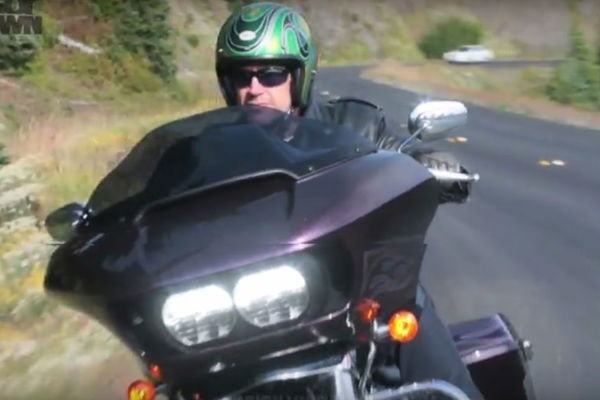First ride: 2017 Kawasaki Z1000SX review
Logical, not radical change make Kawasaki’s best-selling sports tourer even more comfortable and exciting
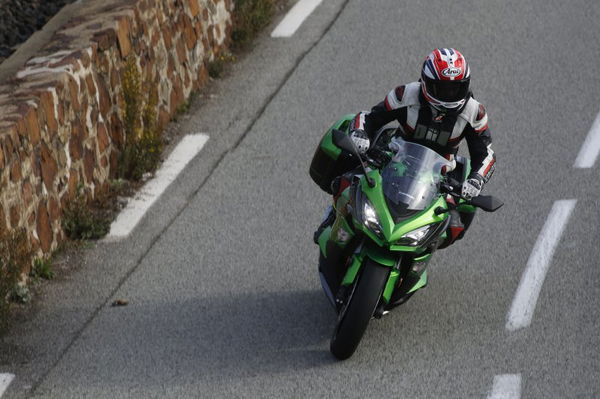
THE PERFECT sports tourer must be one of the most difficult models for a manufacturer to get right, right?
The recipe needs to be a considered blend of two styles of bike that appear to sit at opposite ends of the spectrum but like peanut butter, bacon and banana, create something special when brought together.
Conversations about sports bikes often centre on power, precision, track prowess and pedigree, and saving tenths of a second. With a tourer comfort, plushness, wind protection and tank range are more appropriate areas of focus – stuff that generally isn’t going to help you ping through Craner Curves as fast as you’re capable of.
With the Z1000SX, Kawasaki seems to have hit upon the right recipe and its sales success speaks for itself – since its launch in 2011, it’s consistently been one of Kawasaki UK’s top three sellers.
An update in 2014 endowed it with new suspension and brakes, plus traction control and two power modes. For 2017 the refined 2014 bike has effectively been refined further and Kawasaki says that for every advance of its sporting capability, there’s been a touring advance to match.
The Z1000SX’s restyle is a nice example of how the Kawasaki has paid equal attention to both sporting and touring elements. The restyled bodywork moves the Z1000SX closer to Kawasaki’s sports bikes and a glance at the new, more aggressively styled front and side fairings reveals the influence of the ZX-10R and what Kawasaki calls its ‘Ninja DNA’ - hence why for 2017 it looks like a ZX-10R with high bars (if you squint a bit).
New bodywork doesn’t just make the Z1000SX look sportier; it also contributes to its touring ability because it’s 28mm wider to offer better wind protection round the legs. Chuck in the new 15mm taller double-bubble screen and the ZX did a good job of keeping me protected from both wind and rain.
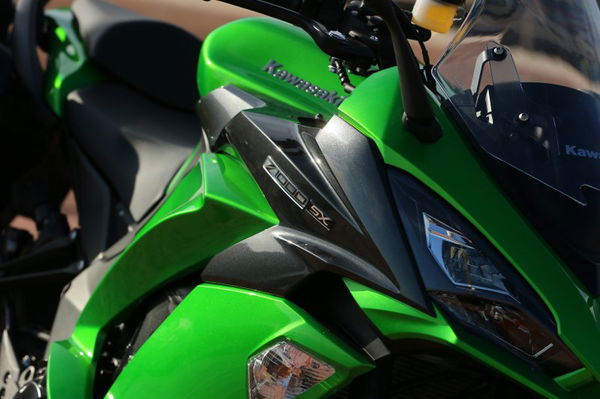
At its lowest setting the screen is much like what you’d get on a sports bike – low enough to crouch behind in a straight line and little else. Raise it up to the highest of its three settings using the lever under the clocks and wind protection is much improved. I’m 5ft 7” and on the motorway found that the screen directed wind towards the middle of my visor, consistently keeping my body free from windblast.
And with 142hp and 81.86lb/ft on tap from the unchanged 1,043cc liquid-cooled four-stroke inline four-cylinder engine, there’s always plenty of power available to inflict some serious wind blast. To put that power in some context, Suzuki’s GSX-S1000FA makes 143hp and 78lb/ft torque, and the BMW S1000XR makes 162hp and 82.6lb/ft.
The 2017 ZSX’s ‘curb mass’ is quoted as 235kg, 4kg heavier than the previous model. Kawasaki classes kerb mass as the ‘mass of the unladen vehicle ready for normal use including all fluids and a full fuel tank.’ That makes it heavier than the 214kg GSX-S1000F and 228kg S1000XR.
Tank capacity remains unchanged at 19 litres – 2 litres more than the Suzuki and one less than the BMW.
Euro4 compliance has been achieved through changes to the main and pre-cats.

The engine is superb – it fuels sweetly, has a great throttle connection and bags of power everywhere. Thanks to its torque, it’ll pull from 2,000rpm at just over 20mph in sixth gear without complaining, so while riding away from Nice on some of the city’s arterial roads, I just stuck it in top and used the torque to carry me forwards.
But the engine isn’t lacking a feisty, sporty temperament. Whenever I pinned the throttle to send the needle of the analogue tacho rushing for the 11,000rpm redline, I was rewarded with rich, smooth power delivery. The engine is most exciting above 7,000rpm, where it pulls with intent, to the soundtrack of a healthy induction roar from 6,000rpm. When the pace quickens, the Z1000SX feels sporty, powerful and exciting.
The engine’s performance is also complimented by a slick, smooth gearbox that benefits from an assist and slipper clutch.
Kawasaki says the smooth power delivery is the result of revised ECU settings, but that’s not the only technological revision on the 2017 Z1000SX because it’s equipped with an Inertial Measurement Unit (IMU). That means the bike’s traction control (with three settings) is lean angle sensitive. Level one is the least intrusive and allows power wheelies, level two cuts in a bit sooner but will allow the front to lift, and level three is for wet riding. The new traction control system makes for a reassuring ride in poor conditions and when cracking the power on along a sun-drenched road, or even a track. It’s derived from the system on the ZX-10R, but with its parameters altered to suit the ZSX’s intended use. I was grateful for it on the rain soaked first day of riding and my only criticism is that without looking at the dash, I could easily feel when it was cutting in because it’s not particularly subtle.
Less technically impressive is the fact that the Z1000SX still doesn't have cruise control - feature which is sure to be missed on long motorway slogs. It's not available as an aftermakret accessory from Kawasaki either, although heated grips are.
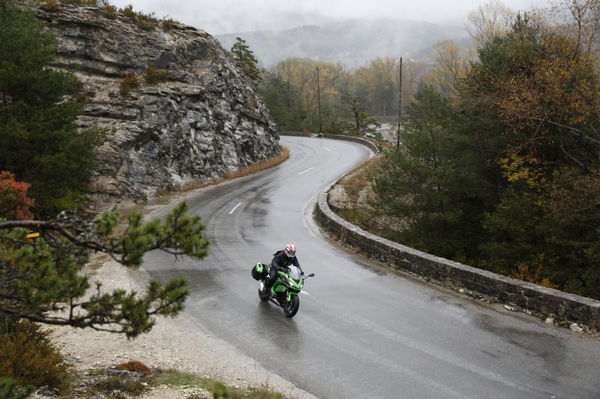
The electronics are controlled using a switch on the left bar. Changing between high and low power modes and adjusting the traction control settings is intuitive and easy, even though cycling from traction control mode one to two means pressing the down selection button, not up.
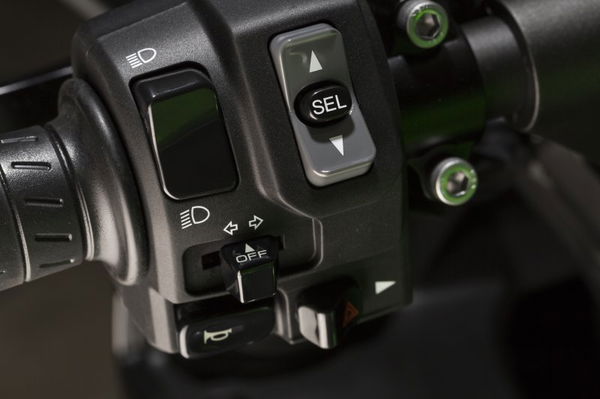
The IMU is also part of the ABS system, so the 2017 Z1000SX also has KIBS – Kawasaki Intelligent anti-lock Brake System. That’s cornering ABS to you and I. The system works to prevent rear wheel lift when leant over under hard braking and also helps the bike trace the rider’s intended line through a corner when trail braking or when having to brake mid-corner – so the bike is less likely to sit up if you need to brake to avoid an obstacle in a bend.
KIBS is a welcome addition to the bike but I don't think its benefit can be fully realised with the Bridgestone S20 tyres, which seemed to conribute to a slightly awkward front end.
The Z1000SX required firm and consistent steering input; I was frequently putting more effort into counter-steering than I usually have to. It’s a feeling that seems accentuated by the high bars, which sit atop tall bar risers. Having to be more dominant and active with the front end meant more of my attention was absorbed by keeping it on the right line. You might call it high-maintenance steering.
Perhaps the Bridgestone S20s are responsible for this feeling. I felt they performed poorly in the wet, threatening to give up, particularly in low-speed turns. Things were better in the dry but aggressive steering and mid-corner line adjustment could easily result in a nervy, juddering warning through the bars.
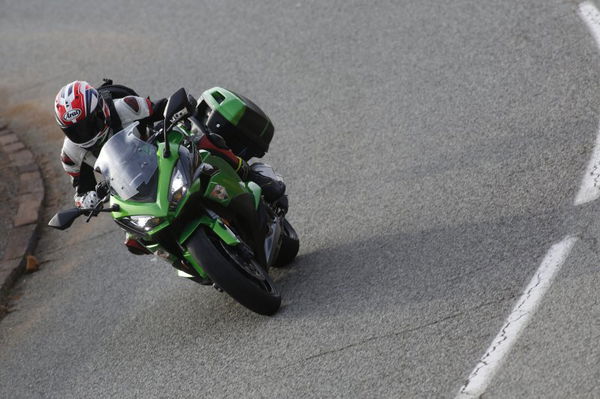
The rear felt slightly better, but the Kawasaki Traction Control may have been helping to compensate for shortcomings.
At the end of a day and a half on the new Z1000SX, I spoke to one of the European technical guys about the front of the bike. I asked whether the 2017 model has received any chassis changes. There’s a new shock linkage, which results in a 5mm lower seat height (815mm). The shock has also received some internal changes in the form of new shims, although he wasn’t able to tell me precisely what’s been done other than the changes are designed to make the rear smoother and more stable.
The bike’s wheelbase is also 5mm shorter at 1440mm.
Externally the 41mm adjustable USB forks remain unchanged but they come with less preload, increased rebound damping and less compression damping – changes which are also intended to improve the ZSX’s comfort and sporty feel. I also established that the shim stacks have been altered, but again, not by how much. The forks gave a consistently plush ride but I never felt completely at ease with what I could get away with when braking and getting set for a corner.
When I told the technical guy my thoughts on the front end, he also pointed the finger at the tyres and admitted he'd heard other 'reports like this'.
The performance of the engine is complimented by an equally impressive set of brakes. At the front, twin Kawasaki-branded four-piston radial-mount monobloc calipers bite on to semi-floating 300mm petal discs. At the rear, there’s a single-piston caliper and 250mm petal disc. What the front brakes lack in sharp initial bite, they more than make up for with lots of power and excellent feel, which is something I was consistently grateful for in the rain.
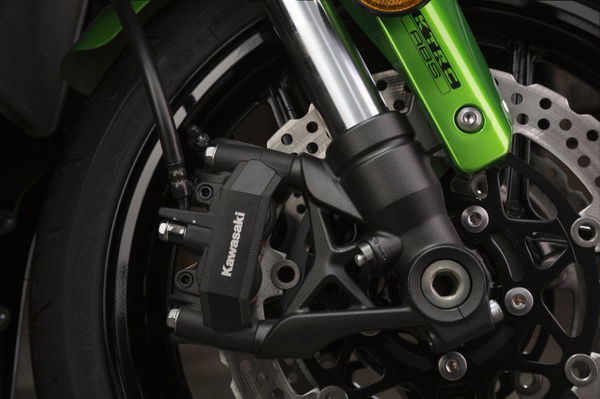
Other changes to the 2017 ZSX include new dual LED head lights, which are unquestionably bright and made the easily bike visible through the drizzly, misty gloom of a rain soaked Autumn afternoon.
Comfort and ergonomics are aided by the addition of an adjustable clutch lever and Kawasaki says both rider and pillion seats are more comfortable thanks to increased padding and change in size (the rider’s seat is wider, the pillion seat is 25mm longer). After seven hours in the saddle, I was still able to feel my arse. In fact, I couldn’t find much to question about the ZSX’s comfort beyond some buzz through the bars at sustained high rpm - which was most noticable when tanking it down the autoroute. As for the riding position? It was comfortable and struck a good balance between touring and sports - on twisty sections I felt primed for attacking corners and when clicking off the miles, my back, neck, head and legs were all left unscathed by time and distance.
The 2017 bike has also been improved because the standard pillion hand rails are now compatible with the panniers. Previously you’d need to buy a set of accessory grips if you wanted to have pannier and give your pillion something to hold on to that wasn’t your own love handles.
On the subject of storage, I rode the bike with and without panniers and was pleased to find that they’re light, spacious enough to comfortably accommodate my Arai RX-7V and quick and easy to fit and remove, using the ignition key. My concern was that they’d make the ZSX feel cumbersome and weighty, but I need not have worried.
The instrumentation is clear and easily readable. I liked the analogue rev counter – there’s something satisfying about seeing the needles spin, rather than the display on a screen change. Speed is displayed on an LCD screen to the right of the tacho, as is the selected power mode and traction control setting. The dash has a programmable shift lift and tells you when the TC is activating and all the usual trip and consumption information is present.
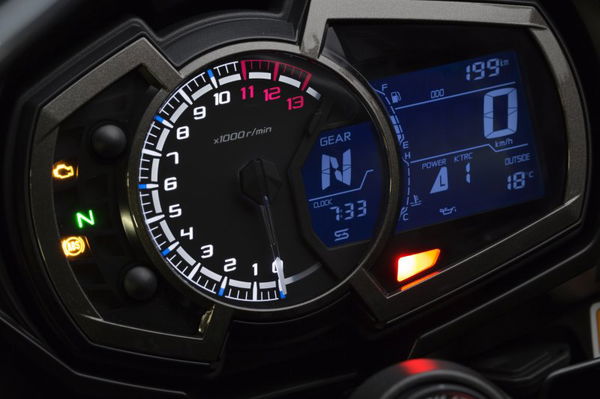
Kawasaki has focused its attention on refining and enhancing the ZSX’s strengths, and addressing its weaknesses. More technology has made it safer while making its performance more accessible in a wide range of conditions. Changes to improve comfort make it a stronger prospect for long rides and everyday use. The result is a bike that feels capable of carrying you to the south of France in comfort before delivering thrills on its twisty roads. As sports tourers go, it’s accomplished but I’ve come away thinking it needs better tyres and maybe some suspension tweaks to fully realise all its potential.
There’s no word on price yet, but we should know before Motorcycle Live. It’ll be available in early January.
Model tested: 2017 Kawasaki Z1000SX
Price: Available mid-November
Engine: 1,043cc liquid-cooled four-stroke inline-four
Suspension: Front - 41mm-diamter adjustable USD forks / Rear - Adjustable gas charged shock with remote preload adjuster
Brakes: Front - Four-piston radial-mount monobloc calipers bite ad semi-floating 300mm petal discs / Rear: Single-piston caliper and 250mm petal disc
Power: 142hp at 10,000rpm
Torque: 81.86lb/ft at 7,300rpm
Weight: 235kg kerb mass
Tank capacity: 19 litres
Availability: Early January 2017
Colours: ‘Candy Lime Green / Metallic Carbon Gray’, ‘Metallic Spark Black / Metallic Graphite Gray’ and ‘Candy Burnt Orange / Metallic Carbon Gray’
